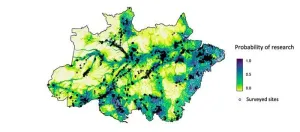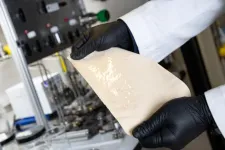(Press-News.org) WEST LAFAYETTE, Ind. – The Space Age is leaving fingerprints on one of the most remote parts of the planet — the stratosphere — which has potential implications for climate, the ozone layer and the continued habitability of Earth.
Using tools hitched to the nose cone of their research planes and sampling more than 11 miles above the planet’s surface, researchers have discovered significant amounts of metals in aerosols in the atmosphere, likely from increasingly frequent launches and returns of spacecraft and satellites. That mass of metal is changing atmospheric chemistry in ways that may impact Earth’s atmosphere and ozone layer.
“We are finding this human-made material in what we consider a pristine area of the atmosphere,” said Dan Cziczo, one of a team of scientists who published a study on these results in the Proceedings of the National Academy of Sciences. “And if something is changing in the stratosphere — this stable region of the atmosphere — that deserves a closer look.” Cziczo, professor and head of the Department of Earth, Atmospheric, and Planetary Sciences in Purdue’s College of Science, is an expert in atmospheric science who has spent decades studying this rarefied region.
Led by Dan Murphy, an adjunct professor in the Department of Earth, Atmospheric, and Planetary Sciences and a researcher at the National Oceanic and Atmospheric Administration, the team detected more than 20 elements in ratios that mirror those used in spacecraft alloys. They found that the mass of lithium, aluminum, copper and lead from spacecraft reentry far exceeded those metals found in natural cosmic dust. Nearly 10% of large sulfuric acid particles — the particles that help protect and buffer the ozone layer — contained aluminum and other spacecraft metals.
Scientists estimate that as many as 50,000 more satellites may reach orbit by 2030. The team calculates that means that, in the next few decades, up to half of stratospheric sulfuric acid particles would contain metals from reentry. What effect that could have on the atmosphere, the ozone layer and life on Earth is yet to be understood.
Scientists have long suspected that spacecraft and satellites were changing the upper atmosphere, but studying the stratosphere, where we don’t live and even the highest flights enter only briefly, is challenging.
As part of NASA’s Airborne Science Program, Murphy and his group fly a WB-57 airplane to sample the atmosphere 11.8 miles (19 km) above the ground in Alaska, where circumpolar clouds tend to form. Similar measurements were made by Cziczo and his group from an ER-2 aircraft over the continental United States. Both groups use instruments hitched to the nose cone to ensure that only the freshest, most undisturbed air is sampled.
The sheltering sky
Like the view of the unruffled surface of the ocean, the stratosphere appears untroubled — at least to human eyes. Life and civilization take place mostly on the planet’s surface and in the troposphere, the atmosphere’s very lowest layer. The stratosphere is a surprisingly stable and seemingly serene layer of the atmosphere.
The stratosphere is also the realm of the ozone layer: that gaseous marvel that acts as a global tent to shield the planet and all life on it from the searing, scorching rays of ultraviolet radiation. Without the ozone layer, life would likely never have arisen on Earth. And without it, life is unlikely to be able to continue.
The last decades have been eventful for the stratosphere. The ozone layer came under threat from chlorofluorocarbons in the 1980s, and only coordinated, sustained global efforts of governments and corporations have begun to bear fruit in repairing and replenishing it.
“Shooting stars streak through the atmosphere,” Cziczo said. “Often, the meteor burns up in the atmosphere and doesn’t even become a meteorite and reach the planet. So the material it was made from stays in the atmosphere in the form of ions. They form very hot gas, which starts to cool and condense as molecules and fall into the stratosphere. The molecules find each other and knit together and form what we call meteorite smoke. Scientists recently started noticing that the chemical fingerprint of these meteoritic particles was starting to change, which made us ask, ‘Well, what changed?’ because meteorite composition hasn’t changed. But the number of spacecraft has.”
What goes up
Spacecraft launches, and returns, were once international events. The launches of Sputnik and the Mercury missions were front-page news. Now, a quickening tide of innovation and loosening regulation means that dozens of countries and corporations are able to launch satellites and spacecraft into orbit. All those satellites have to be sent up on rockets — and most of that material, eventually, comes back down.
Like the wakes of great ships trolling through the ocean, rockets leave behind them a trail of metals that may change the atmosphere in ways scientists don’t yet understand.
“Just to get things into orbit, you need all this fuel and a huge body to support the payload,” Cziczo said. “There are so many rockets going up and coming back and so many satellites falling back through the atmosphere that it’s starting to show up in the stratosphere as these aerosol particles.”
Of course, shooting stars were the first space-delivery system. Meteorites fall through the atmosphere every day. The heat and friction of the atmosphere peel material off them, just as they do off human-made artifacts. However, while hundreds of meteors enter the Earth’s atmosphere every day, they are increasingly being rivaled by the mass of metals that comprise the tons of Falcon, Ariane and Soyuz rockets that boost spacecraft into space and return again to Earth’s surface.
“Changes to the atmosphere can be difficult to study and complex to understand,” Cziczo said. “But what this research shows us is that the impact of human occupation and human spaceflight on the planet may be significant — perhaps more significant than we have yet imagined. Understanding our planet is one of the most urgent research priorities there is.”
Writer: Brittany Steff, bsteff@purdue.edu
END
Signatures of the Space Age: Spacecraft metals left in the wake of humanity’s path to the stars
Airplane-based research by Purdue scientists detects unprecedented levels of alloy aerosols in the atmosphere
2023-10-16
ELSE PRESS RELEASES FROM THIS DATE:
Stress levels worse in women who have heart attacks with blockages, study finds
2023-10-16
Stress and depression are known to increase risk of heart attack, especially among women. They’ve also been linked to worse recovery. But does stress and depression contribute more to women with heart attacks with open arteries or blocked arteries? That’s what a new study published in the Journal of the American College of Cardiology aimed to find out.
Researchers found stress and depression were indeed common among women at the time of heart attack and for two months after. But they also found that women with heart attacks due to blockages (MI-CAD) in their coronary arteries had higher ...
The new robot is taking its first intuitive steps
2023-10-16
When walking on the sidewalk, a person is able to avoid puddles, other walkers, and cracks in the pavement. It may seem intuitive – and that's because it is.
There’s actually a biological component that allows humans and other mammals to navigate our complex environments. Central Pattern Generators (CPG) are neural networks that produce rhythmic patterns of control signals for limbs using simple environmental cues. When we quickly step away to avoid something blocking our path, that’s ...
Neutrons see stress in 3D-printed parts, advancing additive manufacturing
2023-10-16
Using neutrons to see the additive manufacturing process at the atomic level, scientists have shown that they can measure strain in a material as it evolves and track how atoms move in response to stress.
The automotive, aerospace, clean energy and tool-and-die industries — any industry that needs complex and high-performance parts — could use additive manufacturing,” said Alex Plotkowski, materials scientist in ORNL’s Materials Science and Technology Division and the lead scientist of the experiment. Plotkowski and his ...
How to tell if your boss is a ‘corporate psychopath’
2023-10-16
Findings from research to help the business world identify destructive ‘corporate psychopaths’ will be presented at the Chelmsford Science Festival on Monday, 23 October.
Dr Clive Boddy of Anglia Ruskin University, a pioneer in the field of corporate psychopathy, will discuss his research, published in the International Journal of Market Research, looking at how the financial industry can identify, manage and, if necessary, remove these individuals.
Around 1% of the adult population are ...
Ochsner Health Recipient of the 2023-24 WebMD Choice Awards
2023-10-16
NEW ORLEANS, La. - Ochsner Health was named among the “Best Hospitals According to Patients & Health Care Providers” by WebMD, an online publication for health news and information.
The 2023 WebMD Choice Awards recognized a select group of 167 health systems with Elite Choice Awards, WebMD Patient Choice Awards, and Medscape Physician Choice Awards. Results were gathered via a survey of a national audience encompassing thousands of patients and healthcare clinicians to determine which hospitals they believe deliver the best quality and treatments. The awards program identifies the “best in class” ...
Carnegie Mellon University's Synergy Lab releases three papers on ubiquitous sensing
2023-10-16
Researchers from Carnegie Mellon's Systems, Networking, and Energy Efficiency (Synergy) Lab will present several multi-year studies on their work around ubiquitous sensing at this week's ACM International Joint Conference on Pervasive and Ubiquitous Computing (UbiComp).
The works unveil several innovative systems and explain how the collected data can be converted to offer useful insights, all while ensuring the privacy of the individuals being monitored.
Led by School of Computer Science Associate Professor Yuvraj Agarwal, ...
Insilico Medicine presents data on AI-designed cancer drugs at 3 major cancer conferences
2023-10-16
Clinical stage artificial intelligence (AI) drug discovery company Insilico Medicine (“Insilico”) has been invited to present scientific data on its novel anti-cancer assets at three major upcoming cancer conferences -- the European Society for Medical Oncology (ESMO) conference in Madrid Oct. 20-24, 2023; the Society of Immunotherapy of Cancer (SITC) conference Nov. 1-5, 2023 in San Diego; and the San Antonio Breast Cancer Symposium (SABCS) Dec. 5-9, 2023.
Small molecule oncology ...
American Society of Anesthesiologists recognizes Philip G. Morgan, M.D., and Margaret M. Sedensky, M.D., with its Excellence in Research Award
2023-10-16
SAN FRANCISCO — The American Society of Anesthesiologists (ASA) today presented Philip G. Morgan, M.D., and Margaret M. Sedensky, M.D., with its 2023 Excellence in Research Award in recognition of their extensive research focused on understanding how anesthetics work and whether certain anesthetics are safe for children with mitochondrial disease. The award is presented annually for outstanding achievement in research that has had, or is likely to have, an important impact on the practice of anesthesiology.
Drs. Morgan and Sedensky are professors in the Department of Anesthesiology ...
Study reveals areas of Brazilian Amazon where no ecological research has been done
2023-10-16
Many parts of the Brazilian Amazon are neglected in ecological research, for several reasons, according to an article published in the journal Current Biology. Authored by Joice Ferreira of the Federal University of Pará (UFP) and colleagues from many countries who also belong to the Synergize Consortium, the article identifies the areas missing from ecological research and the factors that have determined these gaps, pinpointing opportunities for the planning of new investments in research ...
New polymer membranes, AI predictions could dramatically reduce energy, water use in oil refining
2023-10-16
A new kind of polymer membrane created by researchers at Georgia Tech could reshape how refineries process crude oil, dramatically reducing the energy and water required while extracting even more useful materials.
The so-called DUCKY polymers — more on the unusual name in a minute — are reported Oct. 16 in Nature Materials. And they’re just the beginning for the team of Georgia Tech chemists, chemical engineers, and materials scientists. They also have created artificial intelligence tools to predict the performance of these kinds of polymer membranes, which could accelerate development of new ones.
The implications are stark: ...
LAST 30 PRESS RELEASES:
Study shows federal safety metric inappropriately penalizes hospitals for lifesaving stroke procedures
Improving sleep isn’t enough: researchers highlight daytime function as key to assessing insomnia treatments
Rice Brain Institute awards first seed grants to jump-start collaborative brain health research
Personalizing cancer treatments significantly improve outcome success
UW researchers analyzed which anthologized writers and books get checked out the most from Seattle Public Library
Study finds food waste compost less effective than potting mix alone
UCLA receives $7.3 million for wide-ranging cannabis research
Why this little-known birth control option deserves more attention
Johns Hopkins-led team creates first map of nerve circuitry in bone, identifies key signals for bone repair
UC Irvine astronomers spot largest known stream of super-heated gas in the universe
Research shows how immune system reacts to pig kidney transplants in living patients
Dark stars could help solve three pressing puzzles of the high-redshift universe
Manganese gets its moment as a potential fuel cell catalyst
“Gifted word learner” dogs can pick up new words by overhearing their owners’ talk
More data, more sharing can help avoid misinterpreting “smoking gun” signals in topological physics
An illegal fentanyl supply shock may have contributed to a dramatic decline in deaths
Some dogs can learn new words by eavesdropping on their owners
Scientists trace facial gestures back to their source. before a smile appears, the brain has already decided
Is “Smoking Gun” evidence enough to prove scientific discovery?
Scientists find microbes enhance the benefits of trees by removing greenhouse gases
KAIST-Yonsei team identifies origin cells for malignant brain tumor common in young adults
Team discovers unexpected oscillation states in magnetic vortices
How the brain creates facial expressions
Researchers observe gas outflow driven by a jet from an active galactic nucleus
Pitt student finds familiar structure just 2 billion years after the Big Bang
Evidence of cross-regional marine plastic pollution in green sea turtles
Patients with clonal hematopoiesis have increased heart disease risk following cancer treatment
Stem cell therapy for stroke shows how cells find their way in the brain
Environment: Up to 4,700 tonnes of litter flows down the Rhine each year
Maternal vaccine receipt and infant hospital and emergency visits for influenza and pertussis
[Press-News.org] Signatures of the Space Age: Spacecraft metals left in the wake of humanity’s path to the starsAirplane-based research by Purdue scientists detects unprecedented levels of alloy aerosols in the atmosphere





